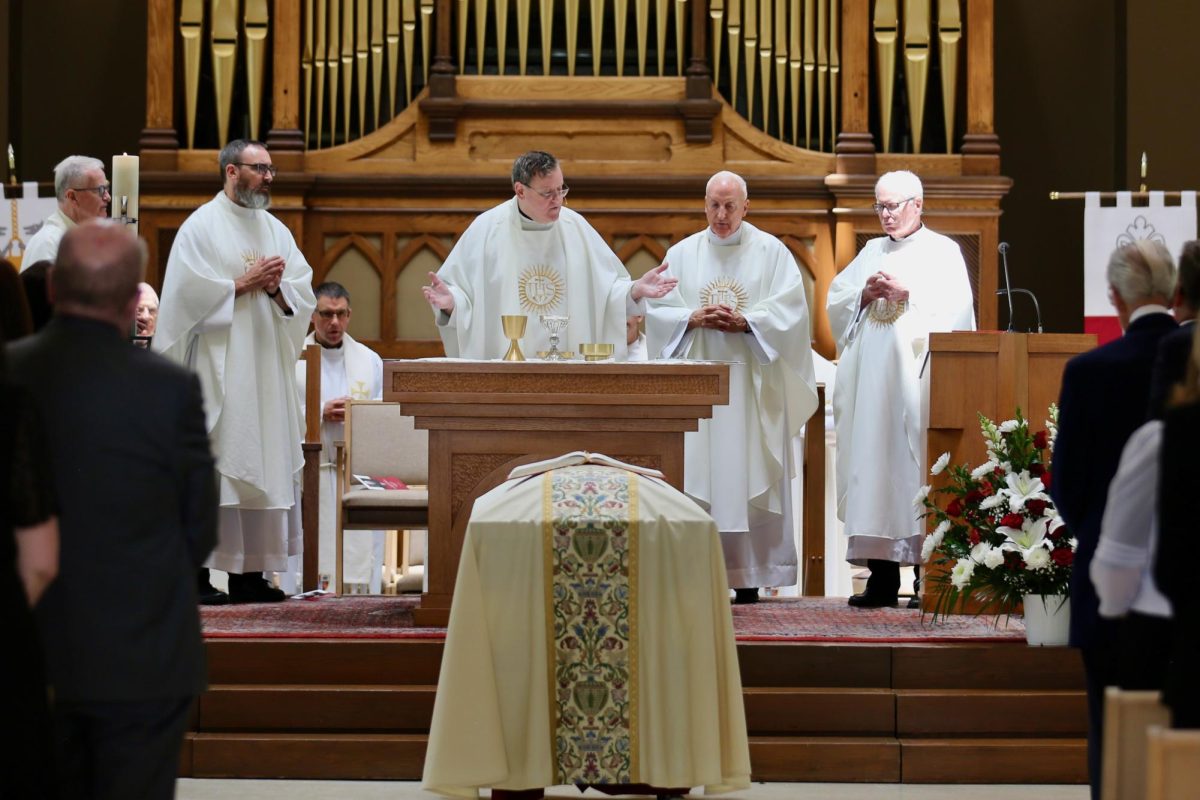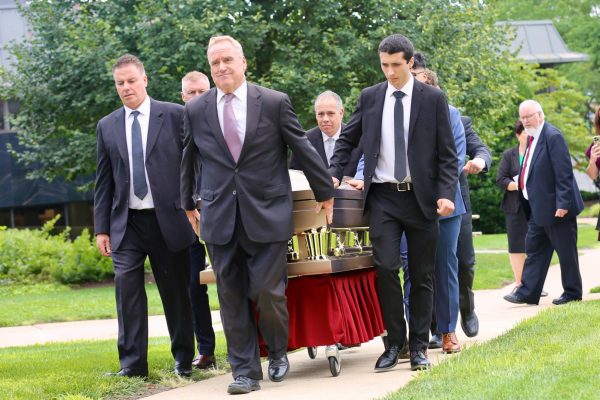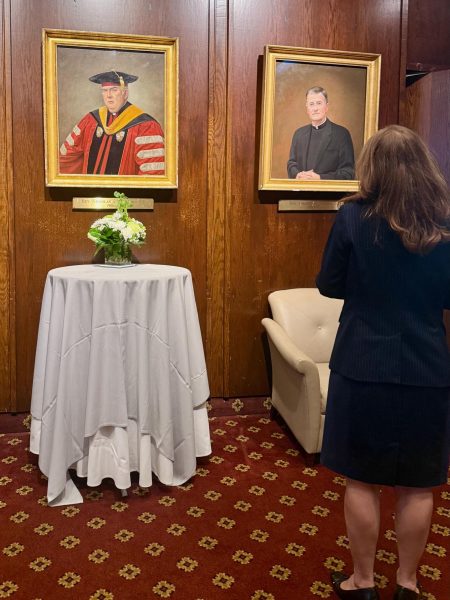
Daniel Joyce '88, S.J., presides over the July 23 funeral mass for Nicholas S. Rashford, S.J., 25th president of St. Joe's. The mass was held in the Chapel of St. Joseph. PHOTO: SAHR KARIMU/THE HAWK
Several hundred people gathered July 23 in the Chapel of St. Joseph for a funeral mass for former university President Nicholas S. Rashford, S.J.
Rashford, who died July 14 at age 85, served as president from 1986 to 2003.
As people left the chapel at the end of mass, the chapel bell rang 25 times. Rashford was the university’s 25th president.
“Twenty five times doesn’t feel enough,” said St. Joe’s President Cheryl McConnell, Ph.D., in remarks before the start of the mass, noting she had known Rashford for over 30 years and considered him a friend. “And there wouldn’t be enough times to chime the bells to recognize Father Rashford’s impact.”
Former St. Joe’s presidents Timothy R. Lannon, S.J., C. Kevin Gillespie ’72, S.J. and Mark C. Reed, Ed.D., also attended the mass.
Rashford was born in Peoria, Illinois, and joined the Jesuits in 1964. He earned his bachelor’s in sociology and philosophy at St. Louis University and his master’s in urban affairs and theology before receiving a doctorate of science in behavioral science from Johns Hopkins University in 1976. He served for three years as dean of the school of management at Rockhurst University, where he met McConnell, then a business faculty member at Rockhurst.

Over his 17 years of leadership, Rashford — often called “Father Nick” or just “Nick” by his friends and colleagues — oversaw the construction of major infrastructure and technology projects on the Hawk Hill campus, including Mandeville Hall and the McShain Hall bridge that connects Lower Merion to Philadelphia. In a 2017 interview with The Hawk, Rashford described how he joined the Delaware River Port Authority to get a seat at the table with those who would ultimately approve the bridge.
“Once I was on the DRPA, every meeting I had, the state treasurer was at my right hand with the secretary of transportation right next to him,” Rashford told The Hawk. “So, every time I had a meeting, I brought up what I needed.”
Rashford’s nephew, Nick Walsh ’94, MBA ’04, who was named after his uncle, described his “Uncle Nick” as ambitious, worldly and people-oriented, reminiscing on “how much joy he got out of life.”
“His platform and his anchors were his faith and his dedication to being genuine,” Walsh said..
Walsh said Rashford valued making connections with others from different backgrounds and “thoroughly enjoyed getting involved in other religions,” recalling how his uncle spent Passover with a local Jewish family.
“They’d invite him in because they knew he was a Jesuit priest, so they were comfortable enough,” Walsh said. “He would form these relationships that are amazing, a super connector.”
Mary Lou Quinlan ’75, who served on the board of trustees during Rashford’s presidency, called Rashford a “bullet.”
“[He was] somebody who had vision, as in futuristic, could see where technology was going and where education was going,” Quinlan said, adding that Rashford had “a big picture of the city, of the country, of the world.”
But Rashford also knew how to make her feel seen and heard, Quinlan said.
“I always felt appreciated and part of the team, and I had a voice, which was important to me,” Quinlan said. “There were very few women on the board, so it mattered to me that, as a woman, he really listened and gave me a platform.”
Jack Finlayson, MBA ’79, who served on the board alongside his sister, Quinlan, described Rashford as someone who embodied Jesuit ideals. Finlayson said Rashford worked hard to distinguish St. Joe’s from other universities in the area by being both a “visionary” and “operating entity.”
“The two things I think about with Father, other than him being fun to be around, are the logic and discipline that he showed and how disciplined he was in his follow-up approach to getting things done,” Finlayson said.
Rashford also established St. Joe’s executive master of business administration program and continued to teach as professor of management until 2021.

Michael C. Margree, S.J., whom Rashford had asked to give the homily at his funeral mass, described Rashford’s dedication to young people, exemplified by “expeditions to Olive Garden.”
“He would just gather a group, and he would say mass for them and then boom, we would be off to Olive Garden,” Margree said.
Beyond Hawk Hill, Rashford chaired the City Avenue District — a commercial and professional district connecting Philadelphia and Lower Merion township — for four years. A sophomore residence hall on City Avenue bears his name.
Don DiJulia ’67, an officer in university advancement who first met Rashford when he was named the university’s athletics director in 1988, said Rashford taught him many things, including “be curious” and “engage with people.” DiJulia described him as “arguably the most influential person in our history.”
Ronald Dufresne, Ph.D., professor of management, was also touched by Rashford’s persona and credits Rashford with deeply influencing his pedagogy when they co-taught a management course. Dufresne called Rashford a “kind, warm, humble man” and a “really great friend and mentor.”
Dufresne said Rashford’s legacy is “the purest Jesuit ideal of seeing a problem and fixing it.” He also credited Rashford with exemplifying “humbition” — a term coined by a fellow Jesuit, William J. Byron ’51, S.J., who died in 2017.
“I see in Father Nick the embodiment of that ‘humbition’ — a very humble, grounded person, human, and very ambitious,” Dufresne said. “So to see how great St. Joe’s is and will continue to be, and to see how that traces back to Father Rashford, I think that it’s that lesson of ‘humbition’ that really will resonate with me.”